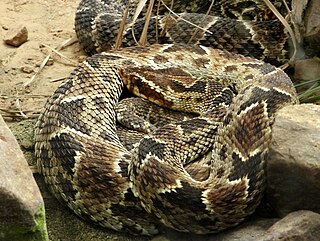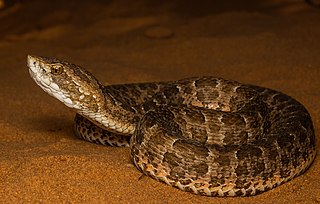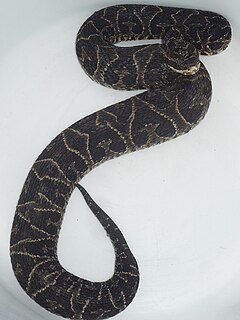
Bothrops leucurus, commonly known as the whitetail lancehead or the Bahia lancehead, is a species of venomous snake, a pit viper in the family Viperidae. The species is endemic to Brazil. There are no subspecies which are recognized as being valid. A female owned by youtuber Venom Central is over six feet long.

Bothrocophias is a genus of venomous snakes in the subfamily Crotalinae of the family Viperidae, known by the common name toadheaded pit vipers. The genus is endemic to northern South America.

Bothrops barnetti, also known commonly as Barnett's lancehead and Barnett's pit viper, is a species of venomous snake, a pit viper in the subfamily Crotalinae of the family Viperidae. The species is endemic to Peru. There are no subspecies that are recognized as being valid.

Bothrops insularis, commonly known as the golden lancehead, is a highly venomous pit viper species endemic to Ilha da Queimada Grande, off the coast of São Paulo state, in Brazil. The species is named for the light yellowish-brown color of its underside and for its head shape that is characteristic of the genus Bothrops. No subspecies of Bothrops insularis are currently recognized. It is one of the most venomous snakes in Latin America.
Bothrops pirajai is a species of venomous snake, a pit viper in the subfamily Crotalinae of the family Viperidae. The species is endemic to Brazil. There are no subspecies that are recognized as being valid.
Bothriechis marchi is a species of pitviper, a venomous snake in the subfamily Crotalinae of the family Viperidae. The species is endemic to Central America. There are no subspecies that are recognized as being valid.

Trimeresurus hageni, commonly known as the Hagen's pit viper, is a species of pit viper, a venomous snake in the subfamily Crotalinae of the family Viperidae. The species is endemic to Southeast Asia. There are no subspecies which are currently recognized as being valid.
Bothrocophias campbelli, commonly known as Campbell's toadheaded viper, the Ecuadorian toadheaded pitviper, and víbora boca de sapo in Spanish, is a species of venomous pitviper in the family Viperidae. The species is endemic to South America. No subspecies are currently recognized.
Bothrocophias colombianus, commonly known as the Colombian toad-headed pitviper, is a species of venomous snake in the family Viperidae. It is endemic to South America.

Bothrops erythromelas, commonly known as the Caatinga lancehead or the jararaca-da-seca, is a species of venomous snake in the family Viperidae. It is endemic to Brazil. It belongs to reptile class.

Bothrocophias hyoprora, or the Amazonian toad-headed pitviper, is a species of venomous snake in the family Viperidae. It is endemic to north-western South America.

Bothrops lutzi, the Cerrado lancehead, is a species of venomous snake in the family Viperidae. The species is endemic to Brazil.

Bothrops itapetiningae, or the São Paulo lancehead, is a species of venomous snake in the family Viperidae. It is endemic to Brazil.

Bothrops jonathani, known commonly as Jonathan's lancehead or the Cochabamba lancehead, is a species of venomous snake, a pit viper in the family Viperidae. The species is endemic to South America.
Bothrops marajoensis, or the Marajó lancehead, is a species of venomous snake in the family Viperidae. It is endemic to Brazil.
Bothrocophias microphthalmus, or the small-eyed toad-headed pit viper, is a species of venomous snake in the family Viperidae. The species is endemic to northwestern South America.

Bothrops pictus, commonly known in English as the desert lancehead, is a species of venomous snake in the family Viperidae. The species is endemic to South America.
Bothrops sanctaecrucis, or the Bolivian lancehead, is a species of venomous snake in the family Viperidae. It is endemic to South America.
Bothrops monsignifer is a species of snake in the family Viperidae. It is native to Peru and Bolivia.











